2022 - 2023 Community Homelessness Report Summary
Brantford-Brant 2022-2023
The Community Homelessness Report (CHR) is an annual Reaching Home reporting deliverable that supports communities to prevent and reduce homelessness using a more coordinated, systems-based and data-driven response. The CHR was designed to support local discussions and decision making, using all of the information about homelessness currently available at the community level. Communities are encouraged to use their CHR data to develop clear plans of action that help them to reach their homelessness reduction targets and to leverage the collective efforts of service providers working across the community, regardless of how they are funded.
This is a summary of the CHR for the 2022-23 reporting cycle. It shows the community’s self-assessment of Reaching Home implementation, which includes the following key components:
- meaningful collaboration between Indigenous and non-Indigenous partners (see Section 1);
- community-level governance, coordinated service delivery (Coordinated Access) and use of a Homelessness Management Information System or HMIS (see Section 2); and,
- an outcomes-based approach (tracking community-level outcomes and progress against targets using a Unique dentifier or By-Name List, referred to as a List; see Section 3).
- If the community was able to report on outcomes and targets, this CHR Summary also includes results for each of the five core outcomes of Reaching Home (see Section 4).
Section 1. Community Context – Collaboration between Indigenous and Non-Indigenous Partners
Does your community, as a Designated Community (DC), also receive Reaching Home Indigenous Homelessness (IH) funding? Yes – DC and IH funding streams co-exist
Specific to Coordinated Access and the HMIS, has there been ongoing, meaningful collaboration between the DC CE and the IH CE and/or IH CAB over the reporting period? No
Describe how this collaboration will happen over the coming year in more detail.
As the CE, we understand from the OFIFC that there is an IH funding stream, however the City as the CE is unaware of the funding amounts, and the memberships related to the IH CAB. As the CE, we would like to develop a relationship with the IH CAB, and understand the needs related to Urban Indigenous homelessness within the City of Brantford and work towards a better partnership.
The CE continues to prioritize liaising and building strong relationships with the Urban Indigenous community and the Urban Indigenous CAB (BAHA) in order to better serve the Indigenous homeless population. Urban Indigenous partners from the following organizations were asked to review and provide feedback on the CHR: Brantford Native Housing.
As referenced above, the CE and CAB will continue to prioritize engagement with the IH CAB moving forward in the on-going work being completed. In 2023 the City of Brantford as the CE will actively engage, consult, for the development of an Urban Indigenous Homelessness Strategy. CE also provided funding in December 2022 to Brantford Native Housing to complete a feasibility study for a potential housing site. Beginning July 2023, the CE began meeting weekly with Brantford Native Housing and other community agencies to support encampments within Brantford and Brant County, specifically targeting the Urban Indigenous community members, and supporting them in transitioning out of encampments.
The City of Brantford will continue to engage partnerships for the development of an Urban Indigenous homelessness strategy. The Urban Indigenous community partners were also invited to share feedback and input regarding the implementation of the Registry Week event and Point in Time Count. This resulted in the amending and adding of questions to the Point in Time Count survey to better engage Urban Indigenous members of the community during the data collection period and obtain meaningful and representative data where possible. Urban Indigenous community partners were in attendance at the Registry Week Event and were provided funds to order and distribute smudge kits and tobacco ties to attendees. In April 2023, CE completed Registry week and the Point in Time Count. For the 2024 Point in Time Count, the CE will directly engage with its Urban Indigenous Partners to further ensure safe collection of data.
Specific to Coordinated Access and the HMIS, has there been ongoing, meaningful collaboration between the DC or Territorial Homelessness (TH) CE and local Indigenous organizations over the reporting period? Yes
Describe this collaboration in more detail.
Indigenous partners were engaged in discussion about the PiT Count survey data collection efforts, and provided their input and feedback on questions that could be added or amended within the survey to best support outreach interactions between volunteers and Indigenous people in the community. For further PiT Counts, we will ensure that the engagement is prioritized well in advance of the event.
Some proposed changes were made in consultation with two of the Indigenous agencies in the community to better understand the Indigenous experiences within the homelessness system of care in hopes of shaping future services and programs that could be developed to assist Indigenous community members to transition into permanent housing. In total, 142 surveys were completed, and 253 clients were considered homeless on the day of the event. More details about the Point in Time count data will provided in fiscal year 5 CHR. Urban Indigenous agencies will be consulted on an ongoing basis to improve annual Point in Time count outreach and data collection efforts. We look forward to honing meaningful partnerhsip with our Urban Indigenous community service providers in developing a cultural intersectional emergency housing services and program delivery whole for Indigenous individuals. During the PiT Count, out of 142 surveys, 52% identified as Indigenous. 53% had their first experience of homelessness as a youth (under the age of 25), and 41% indicate being in foster care – which are both higher than the general survey population. As the CE, we continue to prioritize Urban Indigenous homelessness, and prioritize housing Urban Indigenous homelessness via the BNL.
As the CE, we would like to enhance the relationship with the IH CAB, and understand the needs related to Urban Indigenous homelessness within the City of Brantford and work towards a better partnership.
With respect to the completion of the Community Homelessness Report (CHR), was there ongoing, meaningful collaboration between local Indigenous and non-Indigenous organizations and, where applicable, the IH CE and/or IH CAB? No
What is the plan to ensure meaningful collaboration occurs during next year’s CHR process?
As the CE, we would like to work and enhance the relationship with the IH CAB, and understand the needs related to Indigenous homelessness within the City of Brantford and work towards mindful partnership.
The City of Brantford intends to explore participation in community research alongside Indigenous-led community partners to better understand the experiences of urban Indigenous individuals experiencing homelessness. The CE will also be engaging Indigenous partners in conversation to seek advice on the development of recommended practices for meaningful engagement. In addition, members of this team will make efforts to attend local Indigenous events, community gatherings and formal annual meetings to help build strong relationships between local Indigenous agencies and non-Indigenous community partners.
Does your community have a separate IH CAB? Yes
Was the CHR also approved by the IH CAB? No
Section 2. Coordinated Access and Homelessness Management Information System (HMIS) Self-Assessment
The table below provides a summary of the work your community has done so far to meet the Reaching Home minimum requirements for Coordinated Access and an HMIS.
| Met | Started | Not Yes Started | |
|---|---|---|---|
| Number of minnimum requirements | 18 | 0 | 0 |
The table below shows the percentage of minimum requirements completed for each core Coordinated Access component.
| Governanace | HMIS | Access Points to Service | Triage and Assessment | Coordinated Access Resource Inventory | Vacancy Matching and Referral |
|---|---|---|---|---|---|
| 100% | 100% | 100% | 100% | 100% | 100% |
Summary Comment
Are there particular efforts and/or issues that you would like to highlight for this reporting period related to your community’s work to achieve the Reaching Home minimum requirements?
This community is sustaining a successful Coordinated Access system and has achieved a quality By-Name List to continue identifying high-priority individuals experiencing homlessness. The Housing Stability team will be including community partners at the Built for Zero improvement advisory meetings in the future to promote engagement from service providers and highlight the importance of addressing system barriers and data quality concerns.
Section 3. Outcomes-Based Approach Self-Assessment
Summary Tables - Minimum Requirement
The tables below provide a summary of the work your community has done so far to transition to an outcomes-based approach under Reaching Home.
| Step 1: Has a List | Step 2: Has a real-time List | Step 3: Has a comprehensive List |
|---|---|---|
| Yes | Yes | Yes |
| List was in place as of January 1, 2023 (or earlier) | Can generate monthly data | Has set targets | Has an outcomes-based approach in place |
|---|---|---|---|
| Yes | Outcome 1: Yes | Outcome 1: Yes | Yes |
| Outcome 2: Yes | Outcome 2: Yes | ||
| Outcome 3: Yes | Outcome 3: Yes | ||
| Outcome 4: Yes | Outcome 4: Yes | ||
| Outcome 5: Yes | Outcome 5: Yes |
| List was in place as of April 1, 2023 (or earlier) | Can generate annual data | Has set targets | Has an outcomes-based approach |
|---|---|---|---|
| Yes | Outcome 1: Yes | Outcome 1: Yes | Yes |
| Outcome 2: Yes | Outcome 2: Yes | ||
| Outcome 3: Yes | Outcome 3: Yes | ||
| Outcome 4: Yes | Outcome 4: Yes | ||
| Outcome 5: Yes | Outcome 5: Yes |
Summary Comment
Are there particular efforts and/or issues that you would like to highlight for this reporting period related to your community’s work to transition to an outcomes-based approach under Reaching Home?
The BNL continues to be a tool for case planning amongst service providers to offer strategic supports for the highest priority individuals experiencing homelessness. We continue to engage service providers who are not yet contributing to the BNL to determine their ability or interest to join the homelessness system of care and exchange information to best support vulnerable individuals within the community. The HIFIS system continually undergoes modifications to improve the quality of data with a current effort focused on reducing the high rate of inactivity status changes by identifying profiles with housing history gaps and ensuring a successful merge of duplicates when they occur.
More information about the Unique Identifier List
Step 1. Have a List
Where does data for the List come from?
- HIFIS (checked)
- Excel
- Other HMIS
- Other data source(s)
- Not applicable – Do not have a List yet
Please describe how the List is created using HIFIS: The list is created as a custom report within HIFIS
For the List, does the community have...
A written policy/protocol that describes how interaction with the homeless-serving system is documented: Yes
A written policy/protocol that describes how housing history is documented: Yes
Chronic homelessness
- Federal definition (checked)
- Local definition
From the List, can the community get data for...
Newly identified on the List: Yes
Activity and inactivity: Yes
Housing history: Yes
From the List, can the community get demographic data for...
Age: Yes
Household type: Yes
Gender identify: Yes
Indigenous identity: Yes
Veteran status: Yes
Step 2. Have a real-time List
How often is information about people experiencing homelessness updated on the List?: Weekly
Is people’s interaction with the homeless-serving system (activity and inactivity) updated regularly on the List? Yes Is housing history updated regularly on the List? Yes
Is there a process in place for keeping chronic homelessness status on the List up-to-date? Yes
Step 3. Have a comprehensive List
Does the community have a document that identifies and describes all of the service providers that help people experiencing homelessness with their housing challenges? Yes
Optional question: How does data from the List compare to other community-level data sources that are considered accurate or valid? This is an optional follow-up question for communities that have completed the “Understanding Community-Level Data” worksheet. Community did not complete this optional question.
Step 4. Track outcomes and progress against targets using data from the List
Does the List meet the benchmark of a “Quality By-Name List” confirmed by the Canadian Alliance to End Homelessness? Yes
Section 4. Community-Level Outcomes and Targets - Monthly
Outcome #1: Fewer people experience homelessness (homelessness is reduced overall)
Based on the information provided in the Community Homelessness Report, the community does not have to report monthly community-level data for Outcome #1 for the reporting period.
| March 2020 | March 2021 | March 2022 | March 2023 | March 2024 | March 2025 | March 2026 | March 2027 | March 2028 | Target |
|---|---|---|---|---|---|---|---|---|---|
| 431 | 429 | 215 |
People who experienced homelessness for at least one day (that month) image graph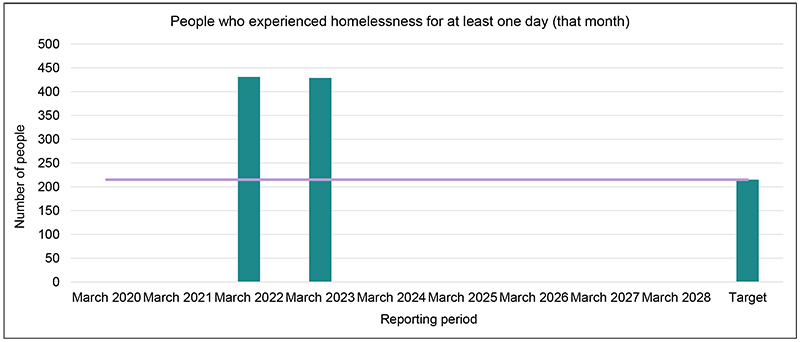
Context for Outcome #1 (monthly):
Please provide context about your results, as applicable.
The BNL has more or less streamlined over the period since March 2022, as although we did see an influx of folks coming into the system (reasons include pandemic) in the early part of the reporting period, however this inflow has slowed down in the recent months in the reporting period. Thus, although the total individuals experiencing homelessness in March of 2022 (431 clients) as compared to March of 2023 (429 clients) seems to have remained consistent, the chronically homeless clients (128 clients in March 2022 vs 147 clients in March 2023) has increased.
Was the HIFIS “Community Homelessness Report” used to generate data for this outcome? No
Was the federal standard for calculating this outcome used (see Annex A)? Yes
How was this outcome calculated?
Homelessness overall: Any client that was identified as “homeless” in HIFIS during the reporting period that metthe following criteria:
- The Client State of the client was Active during the reporting period; and,
- The client does not have an anonymous consent (the client consented to receive services).
Outcome #2: Fewer people were newly identified (new inflows to homelessness are reduced)
| March 2020 | March 2021 | March 2022 | March 2023 | March 2024 | March 2025 | March 2026 | March 2027 | March 2028 | Target |
|---|---|---|---|---|---|---|---|---|---|
| 48 | 30 | 15 |
People who were newly identified (that month) image graph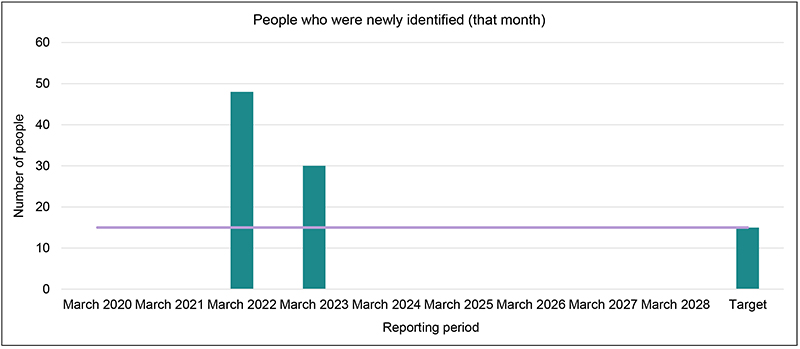
Context for Outcome #2 (monthly):
Please provide context about your results, as applicable.
Fewer people were newly identified (new inflows to homelessness) in this reporting period of March 2023 as compared with March of 2022. During the period between March 2022 and March 2023, data cleaning and HIFIS training activities were conducted leading to merging of newer client profiles with already existing profiles on HIFIS, thereby assisting in having better de-duplicated client data on HIFIS and thereby reduced newly identified individuals on BNL.
Was the HIFIS “Community Homelessness Report” used to generate data for this outcome? No
Was the federal standard for calculating this outcome used (see Annex A)? Not available
How was this outcome calculated?
New inflows into homelessness. Any client that was identified as “homeless” in HIFIS during the reportingperiod that met the following criteria:
- The Client State of the client was Active during the reporting period;
- The client does not have an anonymous consent (the client consented to receive services); and,
- The earliest date that the client became homeless was during the reporting period.
Outcome #3: Fewer people return to homelessness (returns to homelessness are reduced)
| March 2020 | March 2021 | March 2022 | March 2023 | March 2024 | March 2025 | March 2026 | March 2027 | March 2028 | Target |
|---|---|---|---|---|---|---|---|---|---|
| 0 | 0 | 0 |
Returns to homelessness (that month) image graph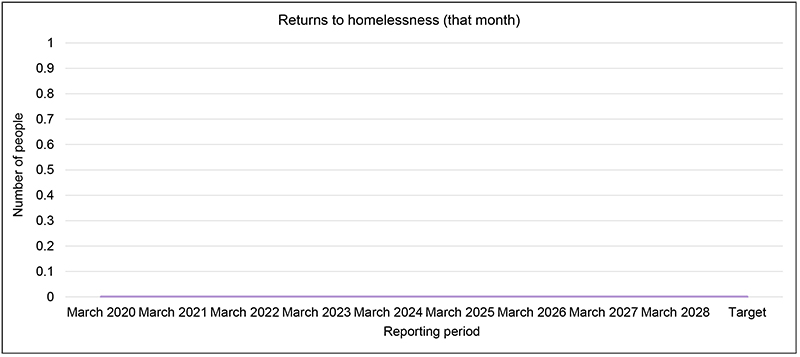
Context for Outcome #3 (monthly):
Please provide context about your results, as applicable.
Although overall (between March 2022 and March 2023) we did see only 2 individuals who returned to homelessness from housed status, for the specific month of March 2023 did not see any individual returning to homelessness. This has been made possible owing to considerable efforts in providing consistent housing retention activities for the individuals.
Was the HIFIS “Community Homelessness Report” used to generate data for this outcome? No
Was the federal standard for calculating this outcome used (see Annex A)? Yes
How was this outcome calculated?
Return to homelessness. Any client that was identified as “homeless” in HIFIS during the reporting period thatmet the following criteria:
- The Client State of the client was Active during the reporting period;
- The client does not have an anonymous consent (the client consented to receive services);
- The client had a housing status of Housed or Transitional immediately prior to their status of Homeless during the reporting period, where the housing status of Homeless was during the reporting period, but the housing status of Housed or Transitional started prior to the reporting period; and,
- The client had a housing status of Homeless at any point prior the Housing Status of Housed or Transitional.
Outcome #4: Fewer Indigenous peoples experience homelessness (Indigenous homelessness is reduced)
| March 2020 | March 2021 | March 2022 | March 2023 | March 2024 | March 2025 | March 2026 | March 2027 | March 2028 | Target |
|---|---|---|---|---|---|---|---|---|---|
| 69 | 98 | 49 |
Indigenous peoples who experienced homelessness for at least one day (that month) image graph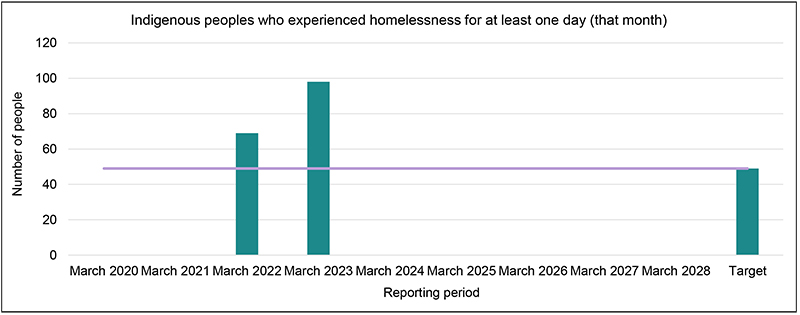
Context for Outcome #4 (monthly):
Please provide context about your results, as applicable.
The number of indigenous individuals on the BNL increased in March of 2023 as compared to March 2022, owing to changes in indigenous statuses of some individuals as well as due to increased coverage of indigenous communities with housing placement activities.
Was the HIFIS “Community Homelessness Report” used to generate data for this outcome? No
Was the federal standard for calculating this outcome used (see Annex A)? Yes
How was this outcome calculated?
Indigenous Homelessness. Any client that was identified as “homeless” in HIFIS during the reporting period that met the following criteria:
- The Client State of the client was Active during the reporting period;
- The client does not have an anonymous consent (the client consented to receive services); and,
- The client was identified as Homeless in HIFIS (Client – Vitals → Indigenous Status).
Outcome #5: Fewer people experience chronic homelessness (chronic homelessness is reduced)
| March 2020 | March 2021 | March 2022 | March 2023 | March 2024 | March 2025 | March 2026 | March 2027 | March 2028 | Target |
|---|---|---|---|---|---|---|---|---|---|
| 128 | 147 | 73.5 |
People who experienced chronic homelessness for at least one day (that month) image graph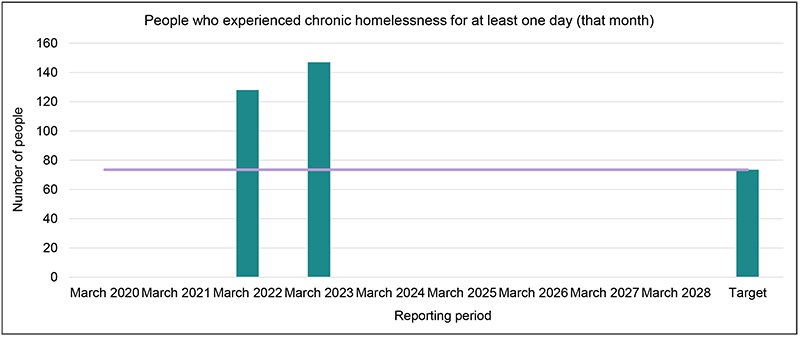
Context for Outcome #5 (monthly):
Please provide context about your results, as applicable.
The BNL has more or less streamlined over the period since March 2022, as although we did see an influx of folks coming into the system (reasons include pandemic) in the early part of the reporting period, however this inflow has slowed down in the recent months in the reporting period. Thus, although the total individuals experiencing homelessness in March of 2022 (431 clients) as compared to March of 2023 (429 clients) seems to have remained consistent, the chronically homeless clients (128 clients in March 2022 vs 147 clients in March 2023) has increased. The aim is to reduce the chronically homeless clients on a priority basis in the coming months.
Was the HIFIS “Community Homelessness Report” used to generate data for this outcome? No
Was the federal standard for calculating this outcome used (see Annex A)? Yes
How was this outcome calculated?
Chronic Homelessness. Any client that was identified as “homeless” in HIFIS during the reporting period that met the following criteria:
- The Client State of the client was Active during the reporting period;
- The client does not have an anonymous consent (the client consented to receive services); and,
- The client was identified as chronically homeless by HIFIS, which is calculated as follows:
- The client was homeless equal or greater than 180 days over the past 365 days; or
- The client was homeless equal or greater than 546 days over the past 1,095 days.
Section 4. Community-Level Outcomes and Targets - Annual
Outcome #1: Fewer people experience homelessness (homelessness is reduced overall)
| 2019-20 | 2020-21 | 2021-22 | 2022-23 | 2023-24 | 2024-25 | 2025-26 | 2026-27 | 2027-28 | Target |
|---|---|---|---|---|---|---|---|---|---|
| 1210 | 605 |
People who experienced homelessness for at least one day (that year)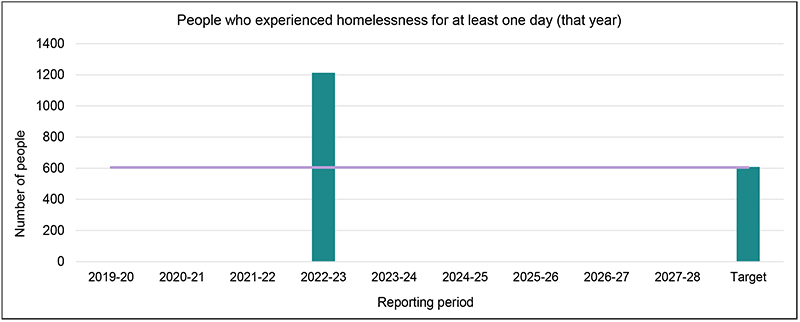
Context for Outcome #1 (annual):
Please provide context about your results, as applicable.
This number represents a total count of all the unique clients who have been served during the reporting period. The BNL has more or less streamlined over the period since March 2022, as although we did see an influx of folks coming into the system (reasons include pandemic) in the early part of the reporting period, however this inflow has slowed down in the recent months in the reporting period. A better comparison of the results of yearly (annual) data on BNL can be done with 2023-24 data.
Was the HIFIS “Community Homelessness Report” used to generate data for this outcome? No
Was the federal standard for calculating this outcome used (see Annex A) Yes
How was this outcome calculated?
Homelessness overall: Any client that was identified as “homeless” in HIFIS during the reporting period that metthe following criteria:
- The Client State of the client was Active during the reporting period; and,
- The client does not have an anonymous consent (the client consented to receive services).
Outcome #2: Fewer people were newly identified (new inflows to homelessness are reduced)
| 2019-20 | 2020-21 | 2021-22 | 2022-23 | 2023-24 | 2024-25 | 2025-26 | 2026-27 | 2027-28 | Target |
|---|---|---|---|---|---|---|---|---|---|
| 472 | 236 |
People who were newly identified (that year) image graph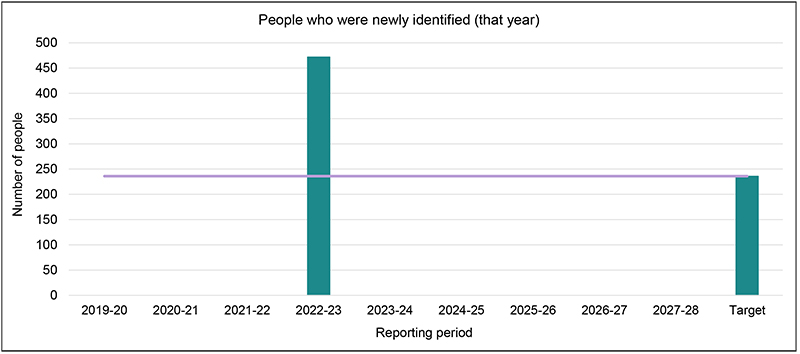
Context for Outcome #2 (annual):
Please provide context about your results, as applicable.
Clients who were newly identified in 2022-23 represent 39% of the overall total individuals experiencing homelessness. Wider outreach activities (e.g. encompassing encampments, etc.), followed by consistent de-duplication and data cleaning activities coupled with HIFIS trainings for newer staff at service providers, is expected to lead to fewer people being newly identified as homeless for the upcoming years, and ultimately reduce this number by 50% in 2027-28.
Was the HIFIS “Community Homelessness Report” used to generate data for this outcome? No
Was the federal standard for calculating this outcome used (see Annex A)? Yes
How was this outcome calculated?
New inflows into homelessness. Any client that was identified as “homeless” in HIFIS during the reportingperiod that met the following criteria:
- The Client State of the client was Active during the reporting period;
- The client does not have an anonymous consent (the client consented to receive services); and,
- The earliest date that the client became homeless was during the reporting period.
Outcome #3: Fewer people return to homelessness (returns to homelessness are reduced)
| 2019-20 | 2020-21 | 2021-22 | 2022-23 | 2023-24 | 2024-25 | 2025-26 | 2026-27 | 2027-28 | Target |
|---|---|---|---|---|---|---|---|---|---|
| 2 | 1 |
Returns to homelessness (that year)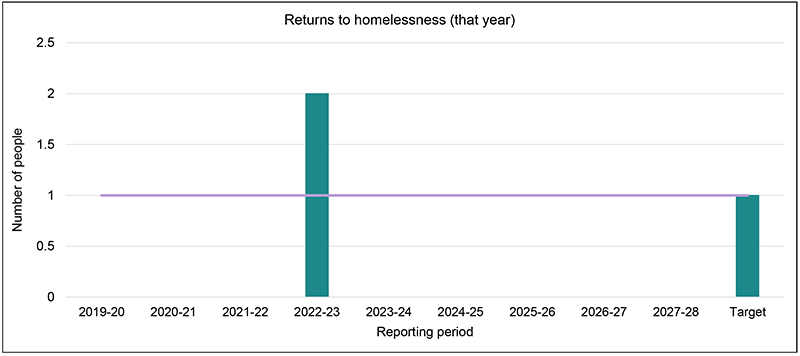
Context for Outcome #3 (annual):
Please provide context about your results, as applicable.
Very few (2) individuals returned to homelessness from housed status between the reporting period (from March 2022 till March 2023) as compared to individuals who returned to homelessness from inactive status. This has been possible owing to considerable efforts in providing consistent housing retention activities for the individuals.
Was the HIFIS “Community Homelessness Report” used to generate data for this outcome?
No Was the federal standard for calculating this outcome used (see Annex A)? Yes
How was this outcome calculated?
Return to homelessness. Any client that was identified as “homeless” in HIFIS during the reporting period thatmet the following criteria:
- The Client State of the client was Active during the reporting period;
- The client does not have an anonymous consent (the client consented to receive services);
- The client had a housing status of Housed or Transitional immediately prior to their status of Homeless during the reporting period, where the housing status of Homeless was during the reporting period, but the housing status of Housed or Transitional started prior to the reporting period; and,
- The client had a housing status of Homeless at any point prior the Housing Status of Housed or Transitional
Outcome #4: Fewer Indigenous peoples experience homelessness (Indigenous homelessness is reduced)
| 2019-20 | 2020-21 | 2021-22 | 2022-23 | 2023-24 | 2024-25 | 2025-26 | 2026-27 | 2027-28 | Target |
|---|---|---|---|---|---|---|---|---|---|
| 206 | 103 |
Indigenous peoples who experienced homelessness for at least one day (that year)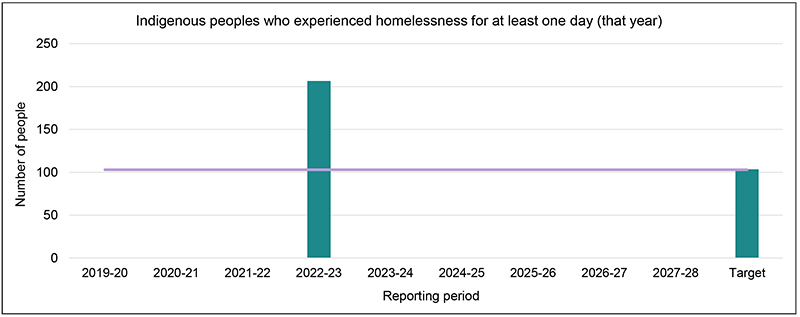
Context for Outcome #4 (annual):
Please provide context about your results, as applicable.
Indigenous clients in 2022-23 represent 17% of the overall total individuals experiencing homelessness. With better and increased coverage of indigenous communities with housing placement activities, the aim is to further reduce homelessness within indigenous individuals to 50% by 2027-28.
Was the HIFIS “Community Homelessness Report” used to generate data for this outcome? No Was the federal standard for calculating this outcome used (see Annex A)? Yes
How was this outcome calculated?
Indigenous Homelessness. Any client that was identified as “homeless” in HIFIS during the reporting period that met the following criteria:
- The Client State of the client was Active during the reporting period;
- The client does not have an anonymous consent (the client consented to receive services); and,
- The client was identified as Homeless in HIFIS (Client – Vitals → Indigenous Status).
Outcome #5: Fewer people experience chronic homelessness (chronic homelessness is reduced)
| 2019-20 | 2020-21 | 2021-22 | 2022-23 | 2023-24 | 2024-25 | 2025-26 | 2026-27 | 2027-28 | Target |
|---|---|---|---|---|---|---|---|---|---|
| 324 | 162 |
People who experienced chronic homelessness for at least one day (that year)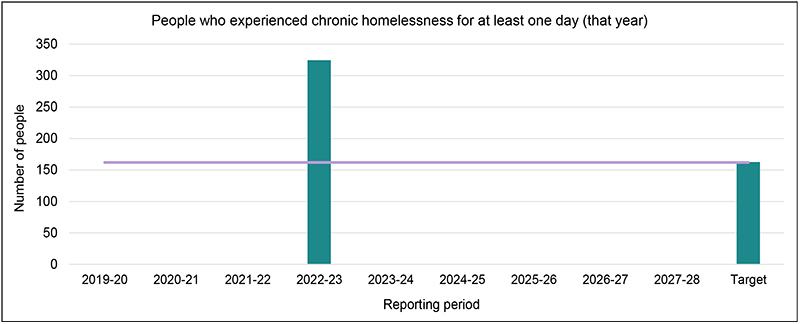
Context for Outcome #5 (annual):
Please provide context about your results, as applicable.
The chronically homeless clients in 2022-23 represent 27% of the overall total individuals experiencing homelessness. The aim is to reduce the chronically homeless clients on a priority basis in the coming months. A better comparison of the results of yearly (annual) data on BNL can be done with 2023-24 data.
Was the HIFIS “Community Homelessness Report” used to generate data for this outcome? No
Was the federal standard for calculating this outcome used (see Annex A)? Yes
How was this outcome calculated?
Chronic Homelessness. Any client that was identified as “homeless” in HIFIS during the reporting period that met the following criteria:
- The Client State of the client was Active during the reporting period;
- The client does not have an anonymous consent (the client consented to receive services); and,
- The client was identified as chronically homeless by HIFIS, which is calculated as follows:
- The client was homeless equal or greater than 180 days over the past 365 days; or
- The client was homeless equal or greater than 546 days over the past 1,095 days.








 Subscribe to this Page
Subscribe to this Page